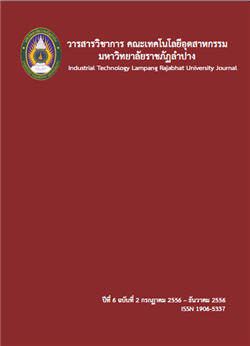การเพิ่มสมรรถนะทางความร้อนของระบบทำน้ำร้อนแสงอาทิตย์ที่มีปั๊ม ความร้อนเสริมโดยการใช้สารละลายเงินนาโนในตัวรับรังสีอาทิตย์
Keywords:
สมรรถนะทางความร้อน, ระบบทำนำ้ร้อนพลังงานแสงอาทิตย์, ปั๊มความร้อน, สารละลายเงินนาโน, thermal performance, solar hot water system, heat pump, silver nanofluidAbstract
งานวิจัยนี้ ได้ใช้สารละลายเงินนาโน ความเข้มข้น 10,000 ppm เป็นของไหลในตัวรับรังสีอาทิตย์ ของระบบทำน้ำร้อนแสงอาทิตย์ที่มีปั๊มความร้อนให้ความร้อนเสริม ในกรณีที่ระดับความเข้มรังสีอาทิตย์ไม่เพียงพอ การศึกษาจะใช้ข้อมูลสมรรถนะของตัวรับรังสีอาทิตย์แบบแผ่นเรียบเมื่อใช้สารละลายเงินนาโน ขนาดพื้นที่รับรังสีประมาณ 2.16 m2 จำนวน 2 แผง ต่อขนานกัน โดยมีคุณลักษณะของตัวรับรังสีอาทิตย์ ได้แก่ FR()e และ FRUL มีค่า 0.816 และ 7.123 W/m2K เทียบกับค่า 0.723 และ 8.314 W/m2K ในกรณีที่ใช้น้ำเป็นสารทำงาน ตัวรับรังสีนี้จะให้ความร้อนแก่ถังน้ำร้อนหุ้มฉนวนอย่างดี ขนาด 500 liter ซึ่งมีปั๊มความร้อนที่ใช้สารทำงาน R134 a ที่มีความต้องการกำลังไฟฟ้า 380 W ในการให้ความร้อนเสริม ในกรณีที่อุณหภูมิน้ำในถังต่ำกว่า 45oC การเปรียบเทียบ จะใช้การจำลองทางคณิตศาสตร์ ภายใต้สภาพการใช้น้ำของอาคารแห่งหนึ่ง ในจังหวัดเชียงใหม่ การศึกษาจะคำนวณความร้อนที่ได้จากตัวรับรังสีอาทิตย์ และปริมาณไฟฟ้าที่ใช้ในระบบปั๊มความร้อน จากผลการศึกษาพบว่า ระบบที่ที่ใช้สารละลายเงินนาโน ตัวรับรังสีอาทิตย์จะสามารถทำงานโดยมีประสิทธิภาพสูงขึ้นกว่ากรณีที่ใช้น้ำเป็นสารทำงาน เนื่องจากสารละลายเงินนาโนสามารถดึงความร้อนจากตัวรับรังสีอาทิตย์ได้ดีกว่า ส่งผลให้ความต้องการความร้อนเสริมจากปั๊มความร้อนลดลง ซึ่งมีผลกระทบโดยตรงในการลดแก๊สเรือนกระจกที่เกิดจากผลิตไฟฟ้าได้ปีละ 2,727.81 kgCO2
Thermal Performance Improvement of Solar Hot Water System Having Assisted Heat Pump with Silver Nano-Fluid in Solar Collector
This study used 10,000 ppm silver nano-fluid as the working fluid in the solar collector of a hot water system which utilized a heat pump as an auxiliary during periods of inadequate solar radiation level. The solar collector was a 2.16 m2 flatplate type, of which the thermal characteristics FR(





